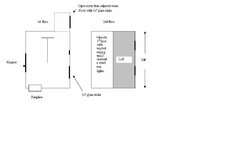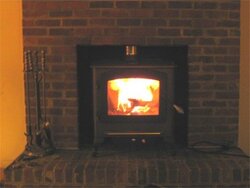Hi,
I am interested in sizing a wood stove. I have a log cabin which is 24 x 52 with two stories. It is 6 inch softwood logs and has an R value of ~8.0 on the sides. A 24 x 30 section is ¾ wide open on the first floor and has a 12 x 30 loft on the upper floor. The peak if the vaulted ceiling is at least 20 feet high. I do not know what insulation is in the vaulted ceiling. The skylights indicate a framing thickness of about 6 inches.
See attached image for drawing.
The fireplace is 40 w x 30.5H x 30D with a 12x12 outside masonry chimney at least 20 feet from the top of the fireplace. I should be able to reline with either 8x8 insulated or 6x6 insulated easily. I live in Bethlehem Township NJ. It is considered Southern North Jersey. I have a Yukon-Eagle oil wood combo furnace in the basement. It is rated at 1gph oil. I used 1500 gallons of the first year and 1200 per year the last two years burning 3 cords of dry slab wood. I keep the house at 68 during the day and 62 at night. If the temp outside is less than 42 the furnace cannot keep up with heat demand when burning wood. However it is nice in “warmer” weather, I only need to visit the furnace a few times a day and the house is toasty. I only burn the wood in the early and late season. The furnace has a 3.5 - 4 .0 fire box and an upstairs thermostat controlled damper that is either all open or closed. I suspect its efficiency. It is sold as a wood stove with oil back up. The oil furnace is exempt from the required AFUE efficiency tests and the wood stove portion is not EPA certified. I would like to reduce my oil consumption to less than 500 gal, bump the temp to a 72, and not have to burn wood in the furnace and stove at the same time. I expect to burn 6.7 cords of slab wood to displace the 1000 gal of oil based on my current oil input btus. If the wood stove is 20% more efficient than the furnace (I hope) then wood consumption gets closer to 5 cords.
What size fire box do I need?
The stove will be placed in the fireplace. My wife does not really like the look of inserts(me either). My wife will yield if it is the only way to go. If it is free standing convection design on all sides except the front is sort of desired/required?
Are there many 5 sided convection free standing stoves available?
Searching the net gets tiring.
Note: Front to back loading would be nice. The Yukon-Eagle has it and it is easier to place wood through its relatively small door than putting wood in the fireplace crosswise.
Thanks,
Dean
I am interested in sizing a wood stove. I have a log cabin which is 24 x 52 with two stories. It is 6 inch softwood logs and has an R value of ~8.0 on the sides. A 24 x 30 section is ¾ wide open on the first floor and has a 12 x 30 loft on the upper floor. The peak if the vaulted ceiling is at least 20 feet high. I do not know what insulation is in the vaulted ceiling. The skylights indicate a framing thickness of about 6 inches.
See attached image for drawing.
The fireplace is 40 w x 30.5H x 30D with a 12x12 outside masonry chimney at least 20 feet from the top of the fireplace. I should be able to reline with either 8x8 insulated or 6x6 insulated easily. I live in Bethlehem Township NJ. It is considered Southern North Jersey. I have a Yukon-Eagle oil wood combo furnace in the basement. It is rated at 1gph oil. I used 1500 gallons of the first year and 1200 per year the last two years burning 3 cords of dry slab wood. I keep the house at 68 during the day and 62 at night. If the temp outside is less than 42 the furnace cannot keep up with heat demand when burning wood. However it is nice in “warmer” weather, I only need to visit the furnace a few times a day and the house is toasty. I only burn the wood in the early and late season. The furnace has a 3.5 - 4 .0 fire box and an upstairs thermostat controlled damper that is either all open or closed. I suspect its efficiency. It is sold as a wood stove with oil back up. The oil furnace is exempt from the required AFUE efficiency tests and the wood stove portion is not EPA certified. I would like to reduce my oil consumption to less than 500 gal, bump the temp to a 72, and not have to burn wood in the furnace and stove at the same time. I expect to burn 6.7 cords of slab wood to displace the 1000 gal of oil based on my current oil input btus. If the wood stove is 20% more efficient than the furnace (I hope) then wood consumption gets closer to 5 cords.
What size fire box do I need?
The stove will be placed in the fireplace. My wife does not really like the look of inserts(me either). My wife will yield if it is the only way to go. If it is free standing convection design on all sides except the front is sort of desired/required?
Are there many 5 sided convection free standing stoves available?
Searching the net gets tiring.
Note: Front to back loading would be nice. The Yukon-Eagle has it and it is easier to place wood through its relatively small door than putting wood in the fireplace crosswise.
Thanks,
Dean



 thats spectacular , you should be proud!
thats spectacular , you should be proud!